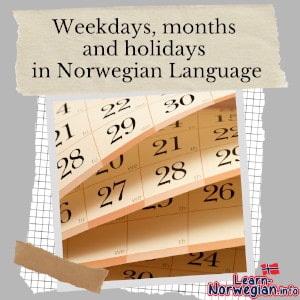Here we explain the days of the week, months and holidays in Norwegian. A simple overview that will definitely help you. ✓

Times of day and times
In Norway, times of day are given in a similar way as in other parts of Europe. The times of day are “morning” (morgen), “forenoon” (formiddag), “afternoon” (ettermiddag), “evening” (kveld) and “night” (natt). The day usually begins at midnight and ends at midnight the following day.
| during the day | om dagen |
| in the morning | om morgenen |
| forenoon | om formiddagen |
| noon | midt på dagen |
| in the afternoon | om ettermiddagen |
| in the evening | om kvelden |
| at night | om natta |
| daily | daglig |
| the day before yesterday | i forgårs |
| yesterday | i går |
| today | i dag |
| tomorrow | i morgen |
| the day after tomorrow | i overmorgen |
The days of the week
In Norway, days of the week are named in a similar way as in other parts of Europe.
Monday is the first day of the week and Sunday is the last day. In Norway, most stores and public institutions are closed on Sunday. Stores are usually open on Saturdays.
| Monday | mandag |
| Tuesday | tirsdag |
| Wednesday | onsdag |
| Thursday | torsdag |
| Friday | fredag |
| Saturday | lørdag |
| Sunday | søndag |

The months
In Norway, the months are named similarly to other parts of Europe.
Each month has 30 or 31 days, except for February, which has 29 days in a leap year and 28 days in a normal year.
| January | januar |
| February | februar |
| March | mars |
| April | april |
| May | mai |
| June | juni |
| July | juli |
| August | august |
| September | september |
| October | oktober |
| November | november |
| December | desember |
![]()
Die Jahreszeiten
In Norway there are four seasons: Spring, summer, autumn and winter.
Spring usually begins in mid-April and lasts until mid-June. The temperatures increase, the days get longer and nature comes to life. It is a popular time for outdoor activities such as hiking and fishing.
Summer usually begins in mid-June and lasts until mid-August. The days are the longest and the temperatures are the highest. It is a popular time for activities such as hiking, fishing, swimming and boating.
Autumn usually begins in mid-August and lasts until mid-October. Temperatures drop and the days become shorter. It is a popular time for activities such as mushroom picking and hunting.
Winter usually begins in mid-October and lasts until mid-April. The days are the shortest and the temperatures are the lowest. It is a popular time for activities such as skiing, snowboarding and cross-country skiing.
It is important to note that the exact dates of the seasons can vary and may differ from place to place due to climate and geography. In particular, in the north and inland, the winter is longer and colder, while in the coastal regions the temperatures are milder.
| spring | vår | fall | høst |
| summerr | sommer | winter | vinter |
Public holiday in Norway
Norway has a number of holidays that include both national and religious holidays.
There are also regional holidays tied to specific events or traditions celebrated in certain parts of the country.
It is important to note that some of these holidays are “floating” and may vary due to the church calendar. Even though most businesses and public institutions are closed on these days, some businesses may be open, especially on New Year’s Day and Christmas Day.
Some of the most important holidays are:
| Maundy Thursday | skjærtorsdag | New Year | nyttår |
| Ascension Day | Kristi Himmelfartsdag | Norwegian national day | nasjonaldagen (17.Mai) |
| Good Friday | langfredag | Whit Monday | andre pinsedag |
| Easter Monday | annen påskedag | Christmas Eve | julekvelden |
| 1. May | første mai | Christmas Day | første juledag |
| Easter | påske | 2nd Christmas Day | annen juledag |
| Pentecost | pinse | New Year’s Eve | nyttårsaften |
| Christmas | jul |



